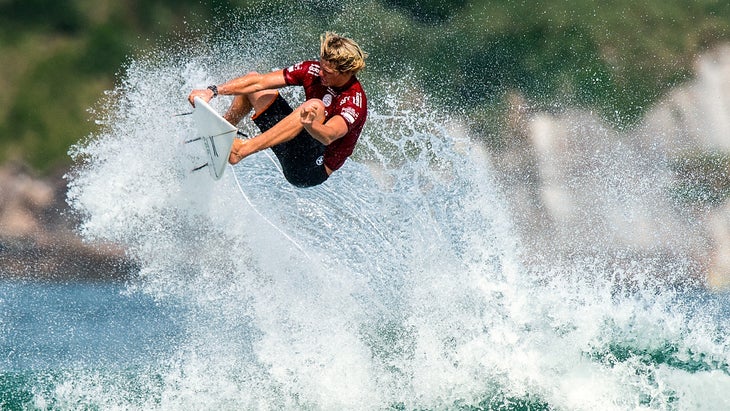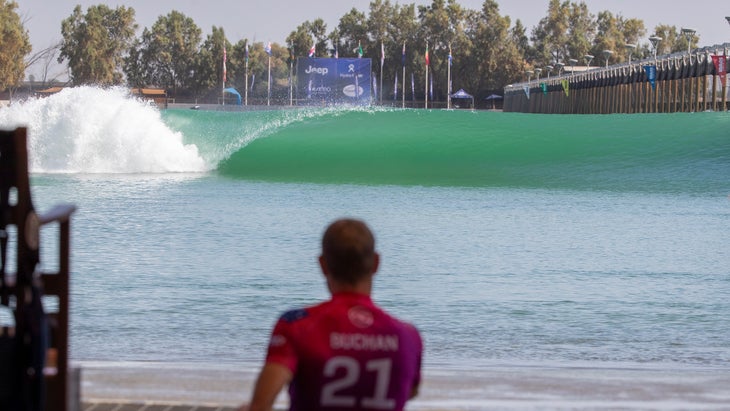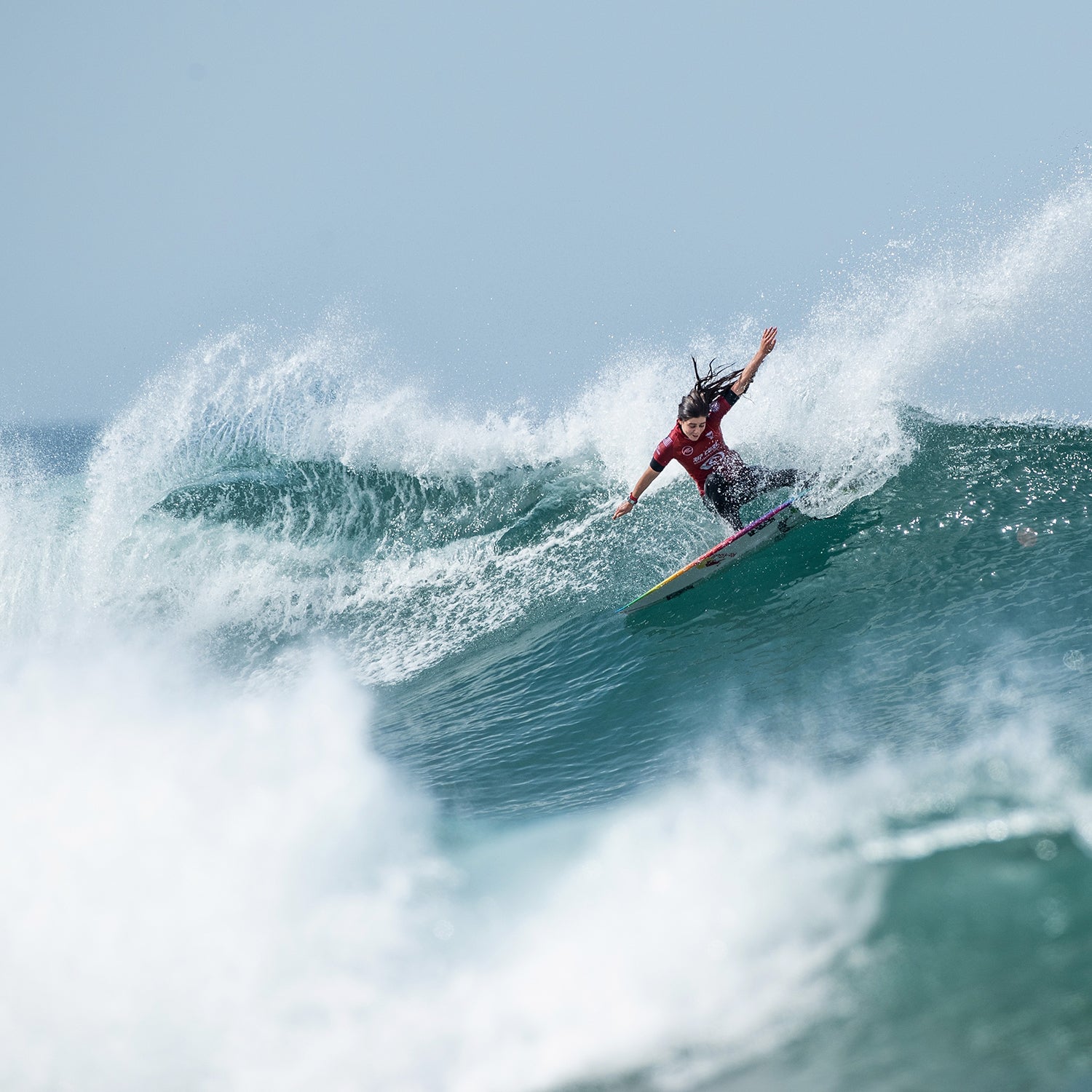It was 1996. Shannon Miller and Kerri Strug had just led the Magnificent Seven to gymnastics gold at the Atlanta Games. Lenny Wilkens coached Scottie Pippen, Charles Barkley, and the rest of Dream Team III to victory for the second Olympics in a row.
Later that year, Fernando Aguerre, president of the International Surfing Association, the sport’s governing body, oversaw the largest ISA World Surfing Games in history—teams from 36 countries converged on Huntington Beach, California, for the 11-day event. The stakes were high: for the first time ever, International Olympic Committee officials were on-site to determine whether surfing should be included in the Summer Games. Team USA, led by pros Taylor Knox and Shane Beschen, would go on to take gold.
“The teams were stocked with stars,” Aguerre Surfer magazine in 2016. “I thought, If we could do this here, why not do it at the Olympics?”
From that point forward, Aguerre’s life was dedicated to getting surfing into the Olympics.
Twenty-five years after Huntington Beach, Aguerre’s dream is finally on the precipice of fruition. Beginning July 25 at 7 A.M. Japan Standard Time, 40 surfers (20 men and 20 women) representing 17 nations will hit the water at Tsurigasaki Surfing Beach to compete for the sport’s first Olympic medals.
Which Surfers Make Up USA’s Dream Team?
Carissa Moore: A four-time world champion from Oahu, Hawaii, Moore is known for her power surfing. While she is a heavy favorite to win gold, it can’t be ignored that she’s more comfortable in larger, punchier surf. The typically small conditions at Tsurigasaki could present a challenge.
Caroline Marks: Few surfers have had such a meteoric rise as this 19-year-old from Melbourne Beach, Florida. In 2018, at age 16, Marks became the youngest-ever surfer to qualify for the World Surf League Women’s World Tour. She’s already won three World Tour events and will no doubt win a world title very soon. Unlike Moore, the waves of Tsurigasaki are similar to those that Marks cut her teeth on in Melbourne Beach—a distinct advantage if the battle for gold comes down to the two American women.
Kolohe Andino: A trip to the Olympics for Andino, 27, wafts of destiny. Born in San Clemente, California, to a former pro surfer father who had his son out in the waves not long after he’d exited the womb, Andino has long been described as the World Tour’s all-American kid and a world-title threat. His home wave, T-Street, is also a beach break similar to Tsurigasaki.

John John Florence: Another element of destiny at play on Team USA is the fact that the two men’s slots ended up going to Andino and 28-year-old Florence. Highly touted as world-title hopefuls when they were both barely out of diapers, Andino and Florence have long been rivals. So far, only Florence has made good on the world-title hype—he’s already got two under his belt. Though he was born with Oahu’s infamous Pipeline in his backyard, Florence possesses the exceedingly rare ability to blend a smooth style with a competitive prowess that transcends wave types and sizes.
What Country Is Team USA’s Main Competition?
Look no further than the current WSL rankings for a tip on that answer. Of the top five men right now, three are Brazilian, including reigning world champion Italo Ferreira and two-time world champion Gabriel Medina.
Currently at number three in the women’s rankings is Brazilian Tatiana Weston-Webb, who is coming off a victory and a runner-up result in the recent Australian leg of the World Tour. At Weston-Webb’s side is her compatriot, veteran competitor Silvana Lima, who is renowned for her tenacity in competition and an ability to upset even the biggest stars when the stakes are highest.
Is There an Individual Wild Card to Watch Out For?
There is little doubt that the crowd’s energy at Tsurigasaki will be focused on 23-year-old Kanoa Igarashi, the best competitive surfer to come out of Japan. Shortly before Igarashi was born, his parents moved the family from Japan to Huntington Beach, California, explicitly so that their son might become a pro surfer. Even as his star rose quickly as a junior surfer, Igarashi never imagined that, one day, he would have the chance to represent his parents’ home country in the Olympics. He can thank Aguerre for that one. All eyes will be on Igarashi when competition kicks off on July 25. No pressure.
Which Other Surfers Should I Be Following?
Never rule out the Aussies. Especially seven-time world champion Stephanie Gilmore. One of the best surfers to grace the sport, Gilmore, like Florence, is blessed with an uncanny ability to surf with the same level of power and finesse, no matter how big or small the waves.
Gilmore’s teammates Sally Fitzgibbons, Owen Wright, and Julian Wilson are all decorated World Tour surfers, hungry to not only win but to represent the surf- and sport-mad Australian people in Tokyo.
What Is the Complete List of Nations Competing in the Event?
Argentina, Australia, Brazil, Chile, Costa Rica, Ecuador, France, Germany, Indonesia, Israel, Japan, Morocco, New Zealand, Peru, Portugal, and Russia.
Read about each athlete representing their nation .
How Will the Event Be Judged?
Five judges will assess surfers on the following :
- Commitment and difficulty
- Innovation and progression
- Variety
- Combination
- Speed, power, and flow
Each wave ridden is awarded a score that falls on a zero-to-ten-point scale, ten being a perfect score that exemplifies all aspects of the judging criteria. Only a surfer’s top two waves are counted toward their final score, meaning the best possible score a surfer can receive in one heat is a 20. It’s the same format that the World Surf League has implemented for years.
Women’s and men’s competition will be broken into three rounds, followed by quarterfinals, semifinals, a bronze match, and a gold match. The medal heats run 45 minutes each.
Weren’t There Rumors that the Event Was Going to Be Held in a Wave Pool?
Indeed, there were. In 2015, following the IOC’s that it had selected surfing for inclusion in the Tokyo Games, much of the discussions around logistics centered on utilizing a wave pool as a way to avoid the ocean going flat during competition. The problem was, no such wave pool—at least one that produced a wave of any quality—existed.
Kelly Slater busted that paradigm. In December of 2015, the 11-time world champion dropped a video on social media that showed him riding an artificial wave so perfect it bordered on hallucination. The space race was officially on.

Slater’s Surf Ranch, located in Lemoore, California, proved good enough for the World Surf League to not only host an annual World Tour event there, but outright purchase the technology to be reproduced at locations around the globe. Representatives from the WSL promptly began scouting pool locations around Tokyo. According to gossip, by the time the Games rolled around, there would be a Surf Ranch 2.0 not far from the city’s center. But the pool was never built. In 2018, the IOC confirmed that the surfing competition would be held in the fun but fickle sand-bottom waves of Chiba prefecture, already host to many of Japan’s surf contests.
In a bit of irony, in June, another wave-pool company, American Wave Machines, that it had completed PerfectSwell Shizunami, a high-quality wave pool located four hours away from Tsurigasaki. Since then a steady stream of clips from visiting pros have been making the rounds on social media, revealing yet another incredibly fun chlorinated wave.
What Happens if There Are No Waves?
Go to the pool! Just kidding. But this question does play into why it has taken a quarter century for Aguerre’s dream to come true. Unlike all other Olympic sporting events, surfing’s playing field, if you will, is fluid. It may rain on the running track, making the rubber slicker, but its size, shape, and lanes remain static. The ocean, on the other hand, is ever changing—no two waves are the same.
There’s just no getting around the very real possibility that the surfers might get skunked. So, as the WSL does for its events, the IOC has padded the Olympic Surfing Festival, as the event is officially dubbed, with four extra days to maximize wave potential. With these built-in “lay days,” the for the event is July 25 through August 1.
But wait! The surfing gods must be watching over Aguerre. Not only do early forecast models show a typhoon passing offshore during the first days of competition, which will produce pumping surf and ideal wind conditions, but long-range projections show a run of great waves through most of the rest of the event period.
“ISA KARMA: Swells are arriving just in time for Olympics surfing!” Aguerre , then added in another post: “27 years paddling and I finally got here.”


